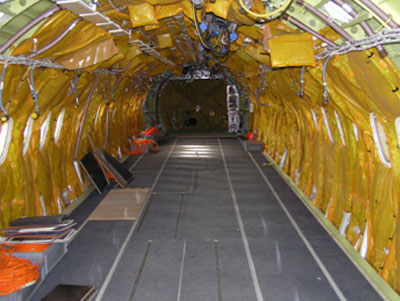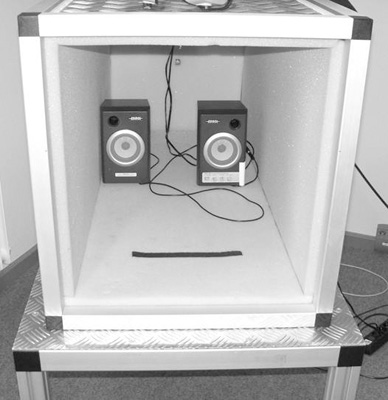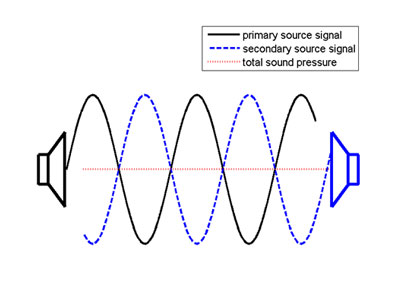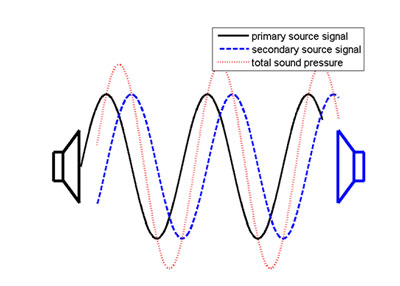Session 6: Noise reduction
Objectives: The used insulation material behind the body shell of a plane is used not only for thermal insulation but also for noise insulation (see fig 10).
This is one example for noise reduction in airplanes. Beside this science and industry work on new concepts for aircrafts to reduce their noise emissions. In this lesson the pupils will understand
- that there are different concepts of noise reduction
- the three main strategies of noise reduction:
- sound reduction at the sound source,
- sound reduction by restraining the transmission of sound;
- noise cancellation (active noise control) using anti-phased signals.
To reduce the negative effects of noise on humans there are mainly three different approaches. The first is to reduce the sound directly at the sound source, for example by technically avoiding it. The second is to restrain the transmission of the sound by using insulating and absorbing materials or increasing the distance to the sound source. The third one is to use interference of sound waves to actively reduce the noise; this is called “active noise control”. These basic principles of interfering into the sound generation and transmission lead to a manifold of technical applications to reduce noise. An example is the disturbance of the transmission. It can be done directly at the sound source by encapsulation or by using insulating earplugs directly at the listeners ear or somewhere in between for example with an insulating wall. Another example the noise cancelation can be done by generating anti-phased signals close to the listener. This technique for example is used in so called noise cancellation headphones which include a microphone and a processor to invert the original signal.
Maximum duration
45 minutes
Material
- Alarm clock
- Tuning fork
- Aluminium plate
- Dlay dough
- Sticky tape
- Pc and loudspeakers
- Software with a frequency generator like “scope”
- Something insulating like a blanket or a cushion

fig 10 Insulation in an airplane

fig 11 Two loudspeakers to show active noise cancellation effect

fig 12 Principle of noise cancellation, in this idealized case the phase shift of 180° causes perfect noise cancellation

fig 13 Problem in noise cancellation applications: a phase shift other than 180° causes an amplification
Introduction/Starters
Play some sound samples of traffic noise like starting airplanes or passing trains/cars. Talk with the pupils about the effect of these noises on passengers and residents. Ask them what ideas for possible solutions they have in mind. Insulating walls near a railway track? What about airports?
Main activities
1) Let the children play around with different sound producing items from session 1 and try to reduce the sound level.
Remember the effect when you hold a tuning fork with its end to a table, it amplifies the sound. Now let them try to disturb the sound generation by sticking some play dough to one or both of the upper arms of the tuning fork.
If an aluminum plate is available make some sounds by hitting it. Then coat most parts of the plate with a thin layer of sticky tape and hit it again on a non-coated area.
2) Remind the pupils of the experiment with the alarm clock in vacuum. Explain that the reason for the decreasing sound volume is an interruption of the sound transmission. Let them think about other ways to do this. Maybe use a blanket over the alarm clock and measure the sound level. Try it with different things like a box or a cushion.
Also talk about the experiment with doubling the distance to the sound source. It caused a reduction of the sound level of 6dB.
3) Use the software “scope“ on a computer to generate two inversely phased sine signals (left and right channel) one for each of the two speakers. Connect only one speaker at a time and let the pupils measure the sound level with a sound level meter. Position the two speakers side by side (see fig 11), connect both and let them measure again. You will notice a hearable decrease of the sound volume. The sound level meter will show a decrease of around 10 dB. This is the principle of anti-noise, the two sine waves cancel each other out. You do not need the box to show this effect.
Hint: Use a sine signal with a frequency of 200 Hz or 400 Hz to show the effect.
Explanation: As shown in fig 12 two sine waves shifted by 180° cancel each other out. The picture shows the idealized case with two plane waves. In the experiment the two loudspeakers produce more or less spherical waves. If the distance between the loudspeakers is small enough, you can hear the attenuation but not a complete cancellation. In fig 13 the problem with this noise reduction method is illustrated. A phase shift other than 180° results in an amplification. In this case it is better to turn off the second source.
Conclusion/Plenary
The optimal way of reducing noise is to reduce it directly on the sound source itself. If this is impossible insulating walls, enclosures and other measures which disturb the transmission path can be used to reduce the noise exposure of the environment.
